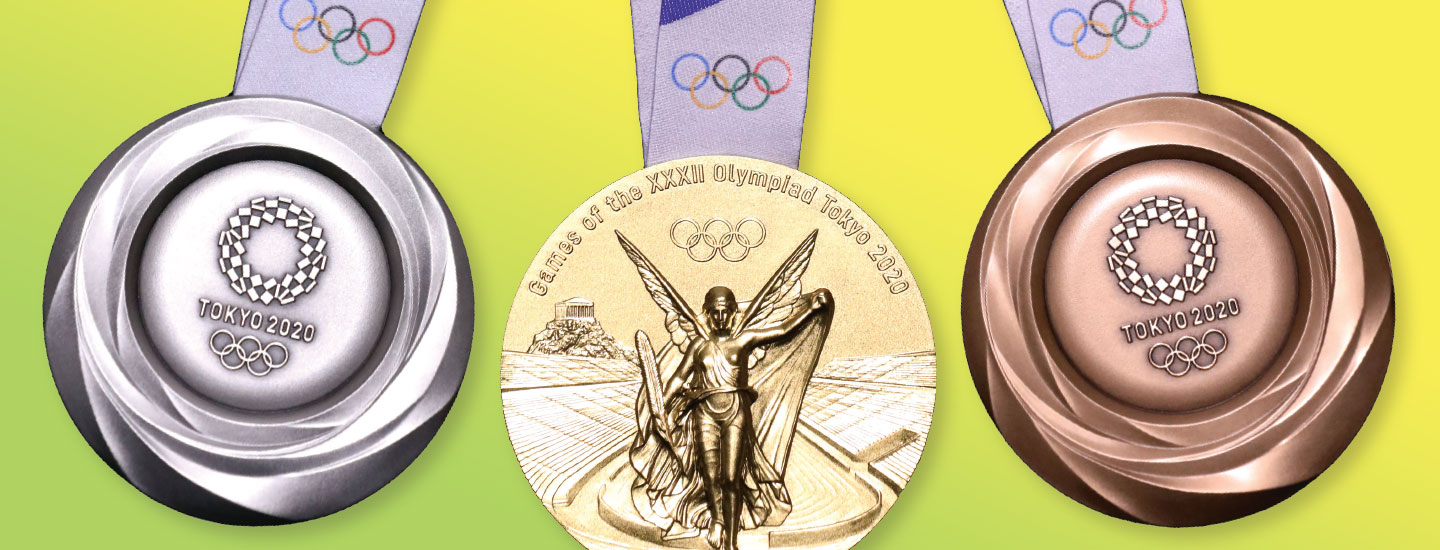Editor's Note: This story has been updated from the print version.
Editor's Note: This story has been updated from the print version.

COURTESY TOKYO2020
STANDARDS
NGSS: Core Idea: PS1.A
CCSS: Writing: 7
TEKS: 6.6A, 7.6A, E.9E, E.9J
Editor's Note: This story has been updated from the print version.
Editor's Note: This story has been updated from the print version.
Medals Go Green
The prizes for the next Olympic Games have been crafted from recycled metal
AS YOU READ, THINK ABOUT how useful materials might be extracted from discarded electronics.
MIKE BLAKE/REUTERS
The summer Olympics were scheduled to kick off in Tokyo, Japan, this July. But on March 24, it was decided to postpone the games until 2021 due to a virus sweeping around the world. Athletes from around the world had hoped to compete in 33 sports and hundreds of events. In preparation for the games, nearly 5,000 Olympic medals were crafted so they could be presented to winners.
The summer Olympics were scheduled to kick off in Tokyo, Japan, this July. But on March 24, it was decided to postpone the games until 2021 due to a virus sweeping around the world. Athletes from around the world had hoped to compete in 33 sports and hundreds of events. In preparation for the games, nearly 5,000 Olympic medals were crafted so they could be presented to winners.
It takes a lot of metal to make all those awards. That’s why Olympic organizers decided to cast the 2020 medals from recycled materials. This would avoid depleting natural resources, making the competition more sustainable.
All the metal in this year’s medals was recovered from old phones, laptops, tablets, and other personal devices—a first in Olympic history (see Mining Electronics). Japan’s citizens donated their old gadgets as part of a nationwide electronics recycling program. Between April 2017 and March 2019, Japan collected about 80,000 tons of this e-waste—a weight roughly equivalent to 800 blue whales. A mobile network company provided an additional 6.2 million used cell phones.
A lot of metal goes into all those awards. So Olympic organizers decided to make the 2020 medals from recycled materials. That way, they wouldn’t use up natural resources. The competition would be more sustainable.
All the metal in this year’s medals came from old phones, laptops, tablets, and other personal devices. That’s a first in Olympic history (see Mining Electronics, right). Japan had a nationwide electronics recycling program. Its citizens donated their old gadgets for the program. Between April 2017 and March 2019, Japan collected about 80,000 tons of this e-waste. That’s about the weight of 800 blue whales. A mobile network company provided another 6.2 million used cell phones.
Recycling facilities extracted gold, silver, copper, and zinc from the electronics (see How Much Metal?). The elements were used to cast Olympic medals in gold, silver, and bronze—a mixture of copper and zinc.
“We believe that Tokyo 2020 has both a duty and an opportunity to actively contribute to global sustainability—and to leave a legacy for young people and future generations,” says Meredith Thatcher, of the Olympic organizing committee.
Recycling facilities removed gold, silver, copper, and zinc from the electronics (see How Much Metal?). Olympic medals were made from these elements. The medals are gold, silver, and bronze, which is a mixture of copper and zinc.
Meredith Thatcher is on the Olympic organizing committee. She says, “We believe that Tokyo 2020 has both a duty and an opportunity to actively contribute to global sustainability—and to leave a legacy for young people and future generations.”
OBTAINING INFORMATION: Research sustainable options for recycling old electronics near you.